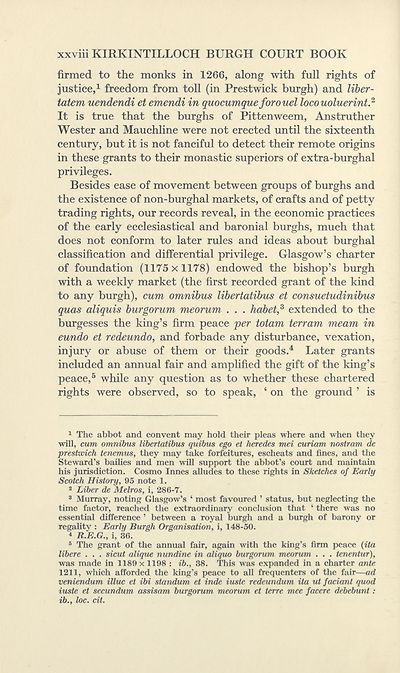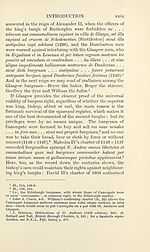Series 3 > Court book of the Burgh of Kirkintilloch 1658-1694
(35) Page xxviii
Download files
Complete book:
Individual page:
Thumbnail gallery: Grid view | List view

xxviii KIRKINTILLOCH BURGH COURT BOOK
firmed to the monks in 1266, along with full rights of
justice,1 freedom from toll (in Prestwick burgh) and liber-
tatem uendendi et emendi in quocumque forouel locouoluerint.2
It is true that the burghs of Pittenweem, Anstruther
Wester and Mauchline were not erected until the sixteenth
century, but it is not fanciful to detect their remote origins
in these grants to their monastic superiors of extra-burghal
privileges.
Besides ease of movement between groups of burghs and
the existence of non-burghal markets, of crafts and of petty
trading rights, our records reveal, in the economic practices
of the early ecclesiastical and baronial burghs, much that
does not conform to later rules and ideas about burghal
classification and differential privilege. Glasgow’s charter
of foundation (1175x1178) endowed the bishop’s burgh
with a weekly market (the first recorded grant of the kind
to any burgh), cum omnibus libertatibus et consuetudinibus
quas aliquis burgorum meorum . . . habet,z extended to the
burgesses the king’s firm peace per totam terram meam in
eundo et redeundo, and forbade any disturbance, vexation,
injury or abuse of them or their goods.4 Later grants
included an annual fair and amplified the gift of the king’s
peace,5 while any question as to whether these chartered
rights were observed, so to speak, ‘ on the ground ’ is
1 The abbot and convent may hold their pleas where and when they
will, cum omnibus libertatibus quibus ego et heredes mei curiam nostrum de
prestwich tenemus, they may take forfeitures, escheats and fines, and the
Steward’s bailies and men will support the abbot’s court and maintain
his jurisdiction. Cosmo Innes alludes to these rights in Sketches of Early
Scotch History, 95 note 1.
2 Liber de Metros, i, 286-7.
3 Murray, noting Glasgow’s ‘ most favoured ’ status, but neglecting the
time factor, reached the extraordinary conclusion that ‘ there was no
essential difference ’ between a royal burgh and a burgh of barony or
regality : Early Burgh Organisation, i, 148-50.
* R.E.G., i, 36.
5 The grant of the annual fair, again with the king’s firm peace (ita
libere . . . sicut alique nundine in aliquo burgorum meorum . . . tenentur),
was made in 1189 x 1198 : ib., 38. This was expanded in a charter ante
1211, which afforded the king’s peace to all frequenters of the fair—ad
veniendum illuc et ibi standum et inde iuste redeundum ita ut faciant quod
iuste et secundum assisam burgorum meorum et terre mee facere debebunt:
ib., loc. cit.
firmed to the monks in 1266, along with full rights of
justice,1 freedom from toll (in Prestwick burgh) and liber-
tatem uendendi et emendi in quocumque forouel locouoluerint.2
It is true that the burghs of Pittenweem, Anstruther
Wester and Mauchline were not erected until the sixteenth
century, but it is not fanciful to detect their remote origins
in these grants to their monastic superiors of extra-burghal
privileges.
Besides ease of movement between groups of burghs and
the existence of non-burghal markets, of crafts and of petty
trading rights, our records reveal, in the economic practices
of the early ecclesiastical and baronial burghs, much that
does not conform to later rules and ideas about burghal
classification and differential privilege. Glasgow’s charter
of foundation (1175x1178) endowed the bishop’s burgh
with a weekly market (the first recorded grant of the kind
to any burgh), cum omnibus libertatibus et consuetudinibus
quas aliquis burgorum meorum . . . habet,z extended to the
burgesses the king’s firm peace per totam terram meam in
eundo et redeundo, and forbade any disturbance, vexation,
injury or abuse of them or their goods.4 Later grants
included an annual fair and amplified the gift of the king’s
peace,5 while any question as to whether these chartered
rights were observed, so to speak, ‘ on the ground ’ is
1 The abbot and convent may hold their pleas where and when they
will, cum omnibus libertatibus quibus ego et heredes mei curiam nostrum de
prestwich tenemus, they may take forfeitures, escheats and fines, and the
Steward’s bailies and men will support the abbot’s court and maintain
his jurisdiction. Cosmo Innes alludes to these rights in Sketches of Early
Scotch History, 95 note 1.
2 Liber de Metros, i, 286-7.
3 Murray, noting Glasgow’s ‘ most favoured ’ status, but neglecting the
time factor, reached the extraordinary conclusion that ‘ there was no
essential difference ’ between a royal burgh and a burgh of barony or
regality : Early Burgh Organisation, i, 148-50.
* R.E.G., i, 36.
5 The grant of the annual fair, again with the king’s firm peace (ita
libere . . . sicut alique nundine in aliquo burgorum meorum . . . tenentur),
was made in 1189 x 1198 : ib., 38. This was expanded in a charter ante
1211, which afforded the king’s peace to all frequenters of the fair—ad
veniendum illuc et ibi standum et inde iuste redeundum ita ut faciant quod
iuste et secundum assisam burgorum meorum et terre mee facere debebunt:
ib., loc. cit.
Set display mode to:
![]() Universal Viewer |
Universal Viewer | ![]() Mirador |
Large image | Transcription
Mirador |
Large image | Transcription
Images and transcriptions on this page, including medium image downloads, may be used under the Creative Commons Attribution 4.0 International Licence unless otherwise stated. ![]()
| Scottish History Society volumes > Series 3 > Court book of the Burgh of Kirkintilloch 1658-1694 > (35) Page xxviii |
|---|
| Permanent URL | https://digital.nls.uk/126713583 |
|---|
| Attribution and copyright: |
|
|---|
| Description | Over 180 volumes, published by the Scottish History Society, containing original sources on Scotland's history and people. With a wide range of subjects, the books collectively cover all periods from the 12th to 20th centuries, and reflect changing trends in Scottish history. Sources are accompanied by scholarly interpretation, references and bibliographies. Volumes are usually published annually, and more digitised volumes will be added as they become available. |
|---|


